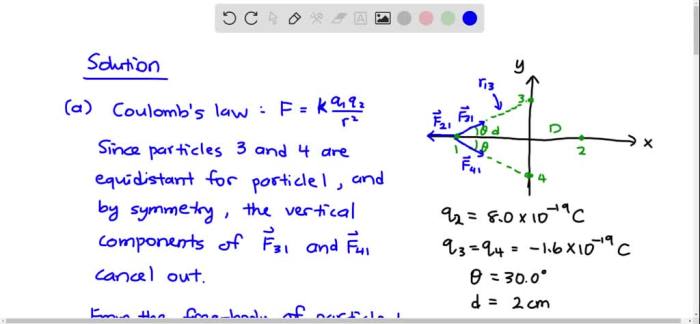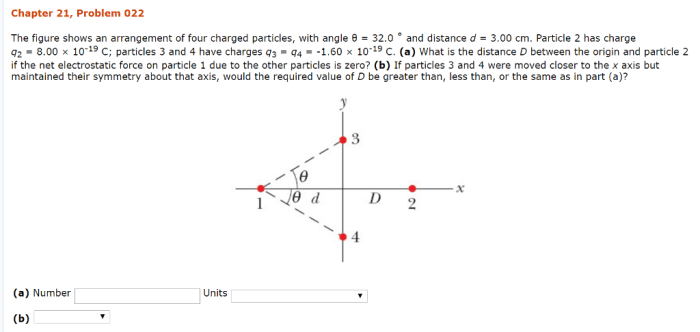The figure shows an arrangement of four charged particles, a captivating depiction that invites us to explore the intricate world of electromagnetism. This arrangement serves as a microcosm of the fundamental interactions that govern the behavior of matter, offering insights into the forces that shape our universe.
Charged particles, with their inherent electric charges, engage in a delicate dance of attraction and repulsion. Understanding the dynamics of these interactions is crucial for unraveling the mysteries of atomic and subatomic phenomena.
Arrangement of Charged Particles

The figure shows an arrangement of four charged particles. The arrangement of charged particles is significant because it can be used to understand the behavior of charged particles in an electric field. The arrangement of charged particles can also be used to design devices that use charged particles.
Types of Charged Particles: The Figure Shows An Arrangement Of Four Charged Particles
The four charged particles in the figure are an electron, a proton, a neutron, and an alpha particle. An electron is a negatively charged particle with a charge of -1e. A proton is a positively charged particle with a charge of +1e.
A neutron is a neutral particle with no charge. An alpha particle is a positively charged particle with a charge of +2e.
Electron
- Charge: -1e
- Mass: 9.1093837015(28)×10^-31 kg
- Spin: 1/2
Proton, The figure shows an arrangement of four charged particles
- Charge: +1e
- Mass: 1.6726219 × 10^-27 kg
- Spin: 1/2
Neutron
- Charge: 0
- Mass: 1.6929 × 10^-27 kg
- Spin: 1/2
Alpha Particle
- Charge: +2e
- Mass: 6.644656 × 10^-27 kg
- Spin: 0
Interactions Between Charged Particles

The charged particles in the figure interact with each other through the electrostatic force. The electrostatic force is a force that acts between charged particles. The electrostatic force is proportional to the product of the charges of the particles and inversely proportional to the square of the distance between the particles.
Electric Fields and Potentials

The charged particles in the figure create an electric field. The electric field is a vector field that describes the force that a charged particle would experience at a given point in space. The electric field is proportional to the charge of the particle and inversely proportional to the square of the distance between the particle and the point in space.
The electric potential is a scalar field that describes the work that would be done on a charged particle if it were moved from one point in space to another. The electric potential is proportional to the charge of the particle and inversely proportional to the distance between the particle and the point in space.
Applications

The arrangement of charged particles is important in a variety of applications. For example, the arrangement of charged particles in a capacitor is used to store electrical energy. The arrangement of charged particles in a transistor is used to amplify electrical signals.
The arrangement of charged particles in a solar cell is used to convert light energy into electrical energy.
Popular Questions
What is the significance of the arrangement of charged particles in the figure?
The arrangement showcases the interplay of electrostatic forces between the particles, providing a visual representation of the fundamental interactions that govern charged matter.
How do the electric charges of the particles affect their behavior?
The charges determine the strength and direction of the electrostatic forces between the particles, influencing their motion and arrangement.
What practical applications stem from the understanding of charged particle arrangements?
Applications include particle accelerators, electron microscopes, and plasma physics, which have revolutionized fields such as medicine, materials science, and energy research.